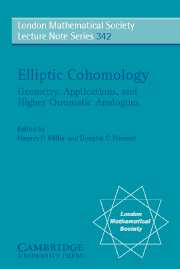Book contents
- Frontmatter
- Contents
- Preface
- Charles Thomas, 1938–2005
- 1 Discrete torsion for the supersingular orbifold sigma genus
- 2 Quaternionic elliptic objects and K3-cohomology
- 3 The M-theory 3-form and E8 gauge theory
- 4 Algebraic groups and equivariant cohomology theories
- 5 Delocalised equivariant elliptic cohomology (with an introduction by Matthew Ando and Haynes Miller)
- 6 On finite resolutions of K(n)-local spheres
- 7 Chromatic phenomena in the algebra of BP*BP-comodules
- 8 Numerical polynomials and endomorphisms of formal group laws
- 9 Thom prospectra for loopgroup representations
- 10 Rational vertex operator algebras
- 11 A possible hierarchy of Morava K-theories
- 12 The motivic Thom isomorphism
- 13 Toward higher chromatic analogs of elliptic cohomology
- 14 What is an elliptic object?
- 15 Spin cobordism, contact structure and the cohomology of p-groups
- 16 Brave New Algebraic Geometry and global derived moduli spaces of ring spectra
- 17 The elliptic genus of a singular variety
8 - Numerical polynomials and endomorphisms of formal group laws
Published online by Cambridge University Press: 03 May 2010
- Frontmatter
- Contents
- Preface
- Charles Thomas, 1938–2005
- 1 Discrete torsion for the supersingular orbifold sigma genus
- 2 Quaternionic elliptic objects and K3-cohomology
- 3 The M-theory 3-form and E8 gauge theory
- 4 Algebraic groups and equivariant cohomology theories
- 5 Delocalised equivariant elliptic cohomology (with an introduction by Matthew Ando and Haynes Miller)
- 6 On finite resolutions of K(n)-local spheres
- 7 Chromatic phenomena in the algebra of BP*BP-comodules
- 8 Numerical polynomials and endomorphisms of formal group laws
- 9 Thom prospectra for loopgroup representations
- 10 Rational vertex operator algebras
- 11 A possible hierarchy of Morava K-theories
- 12 The motivic Thom isomorphism
- 13 Toward higher chromatic analogs of elliptic cohomology
- 14 What is an elliptic object?
- 15 Spin cobordism, contact structure and the cohomology of p-groups
- 16 Brave New Algebraic Geometry and global derived moduli spaces of ring spectra
- 17 The elliptic genus of a singular variety
Summary
Abstract. Endomorphism rings of formal group laws are used to construct families of polynomials which take integer values at the integers. Applications are made to the study of Hopf algebroids of stable cooperations for generalized homology theories and to the study of generalized Bernoulli numbers.
Primary 13B25, 14L05; Secondary 55N20, 11B68
A numerical polynomial is a polynomial with coefficients in ℚ which takes integer values at the integers, or more generally, with coefficients in a number field K taking values in A, the ring of integers of K, when evaluated at elements of A. The study of such polynomials has a long history and a substantial literature (for example). The connection with formal group laws and topology stems from the results of where the notion of a stably numerical Laurent polynomial was introduced: a Laurent polynomial f(x) ∈ ℚ[x, x−1] is stably numerical if xkf(x) is numerical for some integer k. The main result of is that the Hopf algebra of degree 0 stable co-operations for complex K-theory, K0K, is isomorphic to the algebra of stably numerical Laurent polynomials for ℤ. This is essentially a result connecting stably numerical Laurent polynomials with the multiplicative formal group law, and this connection was described explicitly in. The point of the current paper is that this method is applicable to a large class of formal group laws, that its use provides a large supply of stably numerical Laurent polynomials, both for ℤ and for the integers in other number fields, and that when it is applied to the formal group laws associated to elliptic curves new and useful information about the Hopf algebroid of stable cooperations…
- Type
- Chapter
- Information
- Elliptic CohomologyGeometry, Applications, and Higher Chromatic Analogues, pp. 204 - 213Publisher: Cambridge University PressPrint publication year: 2007



